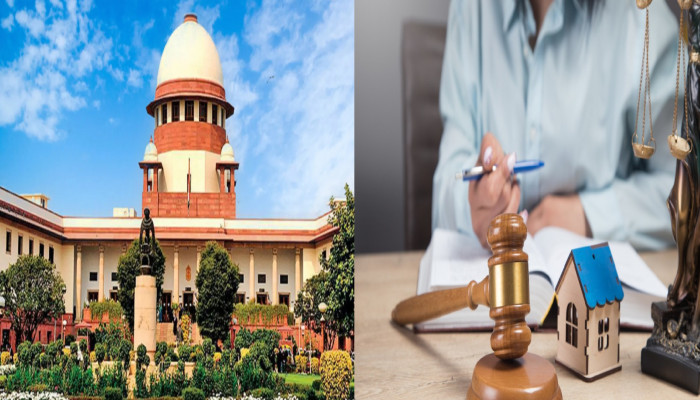SC reverses 1978 verdict, limits state's authority to seize private property
- In Reports
- 04:50 PM, Nov 05, 2024
- Myind Staff
On Tuesday, the Supreme Court ruled that the government cannot take over private property just by claiming it’s for the "common good." In an 8-1 majority decision, the court clarified that private property is not considered "material resources of the community" under Article 39(b) of the Indian Constitution.
This verdict, made by a nine-judge Constitution bench, is a significant step in defining property rights and limiting the government's power over private ownership in India. The Property Owners Association, based in Mumbai, brought a case challenging Chapter VIIIA of the Maharashtra Housing and Area Development Act of 1976. This section of the law lets the State acquire private property and sets compensation at one hundred times the monthly rent. Originally filed in 1992, the petitions were sent to a nine-judge bench in 2002 and, after over two decades, were finally heard in 2024.
In the 1978 case State of Karnataka v. Ranganatha Reddy & Anr., two judges gave separate judgments. Justice Krishna Iyer’s judgment clarified that the term "material resources of the community" includes all resources—whether natural or human-made, whether publicly or privately owned. On the other hand, Justice Untwalia, in his judgment, chose not to discuss Article 39(b). Justice Iyer's interpretation was later upheld by a larger bench in the 1982 case of Sanjeev Coke Manufacturing v. Bharat Coking Coal Ltd. and further reaffirmed in the case of Mafatlal Industries Ltd. v. Union of India.
The Indian Constitution's Article 39(b) instructs the State to try to reallocate resources in a way that best serves the general welfare. The recent Supreme Court decision, however, makes it clear that private property cannot be categorised as "material resources of the community" regardless of whether it might satisfy a particular social or economic requirement. The majority opinion, led by Chief Justice of India DY Chandrachud observed that a more thorough justification is needed for the taking of private property in the name of the common good.
The Chief Justice stated, “Not every resource owned by an individual can be considered a material resource of a community only because it meets the qualifier of material needs.” He went on to say that assessing a resource's nature, effect on public welfare, scarcity, and the effects of its private ownership are all necessary to determine whether it fits into this category.
In an 8-1 decision led by Chief Justice DY Chandrachud, the court ruled that a 1978 judgment by Justice Krishna Iyer—suggesting all private property could be seen as communal resources—is “unsustainable.” The court’s majority view is that while some private resources might fit under Article 39(b), this should be decided individually, not with a broad rule. Justice BV Nagarathna partly disagreed, and Justice Sudhanshu Dhulia fully dissented, arguing that certain private properties could, in fact, meet Article 39(b) goals if they clearly benefit the community.
The Supreme Court bench recognised that since the 1960s, when previous legal theories supporting nationalisation were more common, India's economic outlook has changed dramatically. The Supreme Court stated, "India’s dynamic economic policies over the past three decades have contributed to the country’s rapid growth, positioning it among the world’s fastest-growing economies." The bench therefore reasoned that a strict definition of "community resources" might impede private ownership and the development of entrepreneurship.
Article 31C protects certain laws made under Articles 39(b) and 39(c) of the Constitution, allowing the government to take control of resources necessary for the public’s well-being. However, a recent court decision adds a new perspective, stating that this protection can’t be used to justify taking private property without evaluating the actual benefit to the community. Article 31C was introduced by the 25th Amendment in 1971. Its purpose was to protect the Directive Principles of State Policy (DPSP) listed in Articles 39(b) and 39(c), which recommend policies that the government should aim to follow for the common good.
In the famous Kesavananda Bharati case, the Supreme Court's thirteen-judge bench ruled that the Constitution has a "basic structure" that cannot be altered by amendments. Later, during the Emergency, the 42nd Amendment changed Article 31C. Originally, Article 31C only prioritised certain Directive Principles of State Policy (DPSPs) listed in Article 39(b) and (c), but the 42nd Amendment expanded this priority to cover all DPSPs.
The ruling establishes that, for a resource to be deemed a "material resource of the community," it must be evaluated through various dimensions, including its inherent nature and characteristics, its impact on public welfare, and whether it is state-controlled or privately held. Additionally, the assessment must consider the scarcity and availability of the resource, as well as the implications of concentrated ownership among private entities, ensuring a comprehensive understanding of its role and significance within the community.
The Supreme Court has suggested that the "public trust doctrine" can help identify important resources. This doctrine means that some resources should be kept for the public's benefit, and the government is responsible for managing these resources for all citizens.







Comments